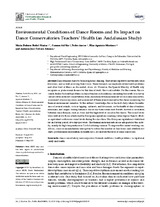Mostrar el registro sencillo del ítem
Environmental Conditions of Dance Rooms and Its Impact on Dance Conservatories Teachers’ Health (an Andalusian Study)
| dc.contributor.author | Redel-Macías, María Dolores | |
| dc.contributor.author | Río, Carmen del | |
| dc.contributor.author | Arezes, Pedro | |
| dc.contributor.author | Aparicio-Martínez, Pilar | |
| dc.contributor.author | Cubero-Atienza, Antonio J. | |
| dc.date.accessioned | 2021-05-17T11:59:31Z | |
| dc.date.available | 2021-05-17T11:59:31Z | |
| dc.date.issued | 2021 | |
| dc.identifier.uri | http://hdl.handle.net/10396/21352 | |
| dc.description.abstract | Dance teachers have to be in long hours dancing. That entails repetitive movements, loud live music, and as well as forcing their voices. These demands can implicate severe health problems and other kind of illness as discomfort, stress, etc. However, the Spanish Ministry of Health only recognize as professional disease for this line of work, the vocal nodules. For this reason, this research studies the health problems in dance teachers in Andalusia, correlating the results of a survey carried out in different conservatories from Andalusia with measurement of noise emissions levels, assessment of noise exposure, and assessment of thermal environment in the classes measuring the thermal environment variables. To the authors’ knowledge, this is the first study where the influence of several sounds, such as tapping, castanets, and live music, on the health of dance teachers, musicians, and singers during flamenco classes has been researched. Results showed a correlation between some diseases, such as stress and the high level of sound in the classes. The sound levels were well above those established by European regulations reaching values higher than 85 dB(A) as equivalent continuous sound levels during the class time. This European regulation is stablished for an 8 h/day period, five days per week. The thermal environments are no adequate for this activity, mainly for high temperatures in Cordoba during summer. To improve the current working conditions, some recommendations were given to reduce the number of class hours and establish rest shifts, provide more information on health risks, or renovate the floor of some classrooms. | es_ES |
| dc.format.mimetype | application/pdf | es_ES |
| dc.language.iso | eng | es_ES |
| dc.publisher | MDPI | es_ES |
| dc.rights | https://creativecommons.org/licenses/by/4.0/ | es_ES |
| dc.source | International Journal of Environmental Research and Public Health 18(10), 5319 (2021) | es_ES |
| dc.subject | Dance conservatory | es_ES |
| dc.subject | Noise exposure | es_ES |
| dc.subject | Thermal conditions | es_ES |
| dc.subject | Health problems | es_ES |
| dc.subject | Occupational safety and health | es_ES |
| dc.title | Environmental Conditions of Dance Rooms and Its Impact on Dance Conservatories Teachers’ Health (an Andalusian Study) | es_ES |
| dc.type | info:eu-repo/semantics/article | es_ES |
| dc.relation.publisherversion | http://dx.doi.org/10.3390/ijerph18105319 | es_ES |
| dc.rights.accessRights | info:eu-repo/semantics/openAccess | es_ES |

